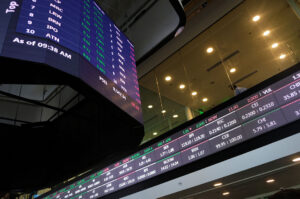Last Tuesday, Dec. 10, I was lucky to meet Argentina’s top diplomat to the Philippines, Ambassador Ricardo Luis Bocalandro. Two officials joined him: the Chief of the Consular Section, Fabricio Sordoni, and the Head of the Cultural, Educational and Tourism Section, Gabriel Hernan Rivera. We talked about economics, inflation, trade, investments, sports, and a bit of history — how some Filipinos went to Argentina and vice versa in the 1780s. And of course, the new Argentina President Javier Milei. I am fond of this leader because he is also free marketer like I am and my allies abroad.
Mr. Bocalandro is particularly concerned about the high inflation suffered by his countrymen for decades, narrating the hardships that his own parents experienced many years ago, a problem that has persisted and even worsened until this decade.
I constructed two tables here on economics, energy, trade and investments. Argentina is very lucky to have a huge land area of 2.74 million square kilometers or nine times that of the Philippines. Their agriculture and livestock business and potential should be big. But our coastline is seven times larger than theirs, mainly because we are an archipelago, and there is lots of water between our many islands.
Our population is 2.4 times larger than Argentina’s but our GDP sizes at purchasing power parity (PPP) values are nearly similar. Our average GDP growth is two to five times faster than theirs. Argentina’s primary energy consumption (PEC) per capita is four times larger than ours, but in total power generation, the Philippines is closing the gap. The average inflation rate in Argentina is indeed bad at 22% in the 2010s and 74% over the last four years (see Table 1).
Argentina’s advantage in power generation is because they have been using nuclear energy since the 1970s. It was the pioneer nuclear energy innovator in South America — they already produced one terawatt-hour (TWh) or 1,000 gigawatt-hours (GWh) of nuclear power in 1974, increasing to 2.9 TWh in 1978, and to 5.8 TWh in 1985, the year that our Philippine Nuclear Power Plant (PNPP) in Bataan should have started operation. Then it further increased to 8 TWh in 1997, slowing down after this, peaking at 10.2 TWh in 2021 and 9 TWh in 2023.
Brazil is the only other South American country that went into this technology. They started nuclear power generation in 1984 with 1.6 TWh. These Brazil nuclear power plants are “twins” or “sister” nuclear plants of our PNPP, along with Korea’s nuclear plants: the three countries’ nuclear plants were all built by Westinghouse, all started construction in the 1970s, all experienced cost escalations, all were scheduled for commissioning and operation in 1984-1986.
The Brazil and Korean nuclear plants have been operating from the mid-1980s to present, with zero accidents. Our PNPP did not start operations — it was killed by domestic politics and nuclear scaremongering. As there was no alternative to that huge 620-MW plant in Bataan, many investors did not come because they foresaw huge blackouts coming. And indeed, we suffered horrible daily blackouts from 1990 to 1992.
I checked the merchandise exports of Argentina and the Philippines, and I was surprised by the following trends in Argentina.
First: Total exports are declining, going from $76 billion in 2013 to $66.8 billion in 2023.
Second: The bulk of their exports are agricultural products including livestock, with $35.7 billion out of $66.8 billion.
Third: There has been a deep industrial hollowing out, with their manufactured exports coming to only $12.6 billion in 2023 or just one-half of the level in 2013.
Fourth: Their exports of office and telecom equipment, and integrated circuits and electrical components, are very small.
The Philippines is trending in the opposite direction.
First: Our agricultural exports are low, and we are a net importer of these commodities.
Second: We are seeing a rise in manufacturing exports, especially in office equipment, integrated circuits and electrical components (see Table 2).
So this is the complementarity in trade between the two countries. The Philippines can buy more agricultural products from Argentina, especially livestock, and Philippines can export manufactured products like office and telecom equipment, integrated circuits and electrical components to Argentina.
Plus we can transfer nuclear power technology, nuclear applications in medicine and healthcare, agriculture and post-harvest treatment, among others.
There is net gains in trade, always. Some losses but more gains. I hope that Philippines-Argentina trade and investments should expand soon.
Bienvenido S. Oplas, Jr. is the president of Bienvenido S. Oplas, Jr. Research Consultancy Services, and Minimal Government Thinkers. He is an international fellow of the Tholos Foundation.






